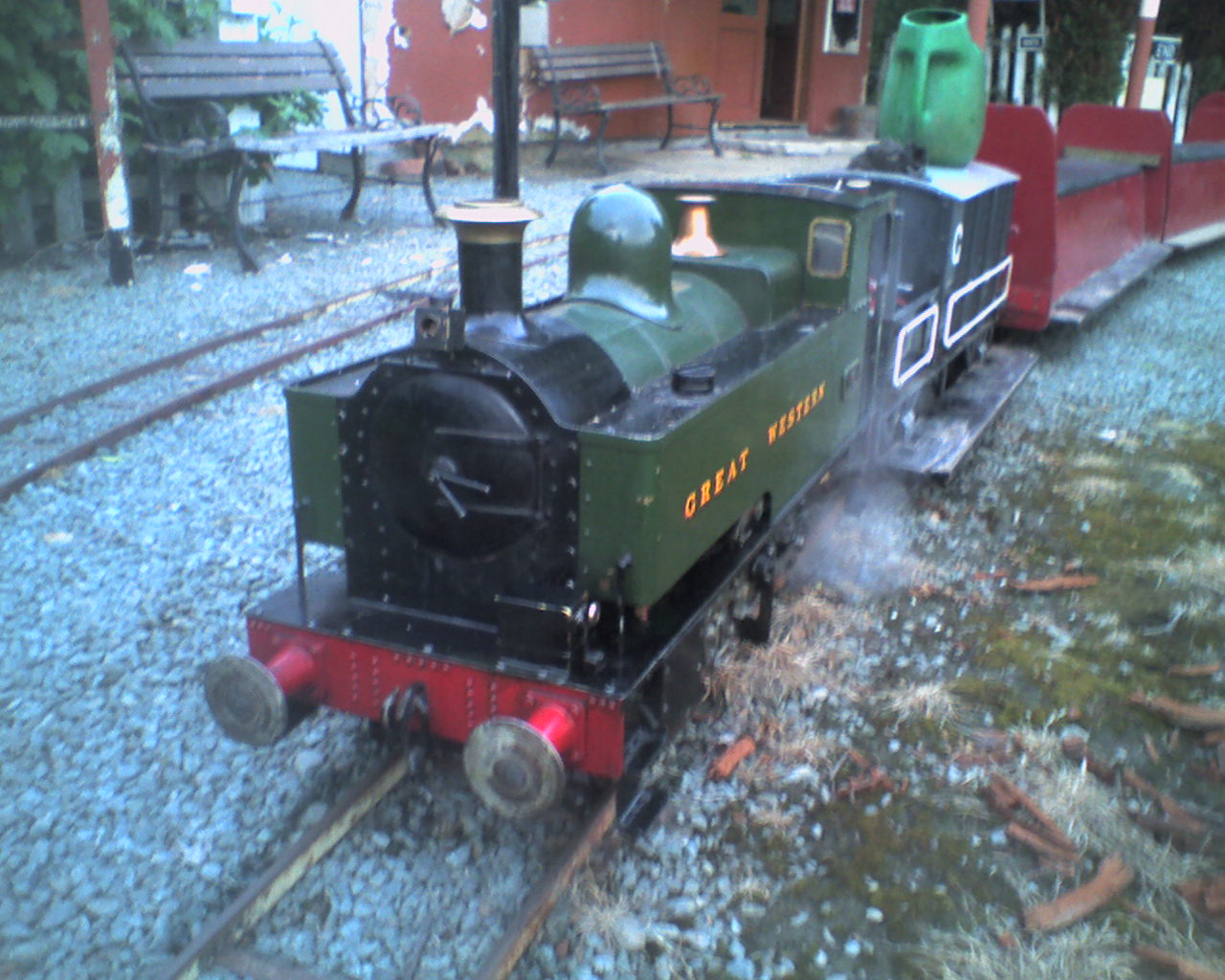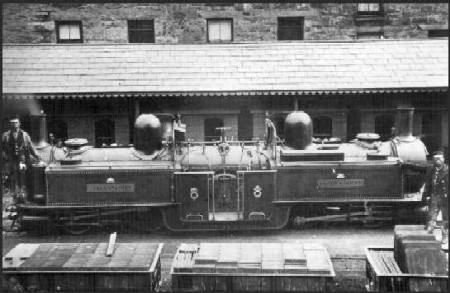|
GWR 1101 Class
The GWR 1101 Class was a class of 0-4-0T side tank steam locomotives built by the Avonside Engine Company to the order of the Great Western Railway in 1926 for dock shunting. British Railways They passed into British Railways British Railways (BR), which from 1965 traded as British Rail, was a state-owned company that operated most of the overground rail transport in Great Britain from 1948 to 1997. It was formed from the nationalisation of the Big Four British rai ... ownership in 1948 and were numbered 1101–1106. Withdrawal All were withdrawn between 1959 and 1960 with all of them being scrapped with none being preserved. Sources * Ian Allan ABC of British Railways Locomotives, winter 1957/8 edition, part 1, page 24 * External links Model of 1101 Class dock tankRail UK database entry 1101 0-4-0T locomotives Avonside locomotives Railway locomotives introduced in 1926 Scrapped locomotives Standard gauge steam locomotives of Great Britain {{UK-steam-loco- ... [...More Info...] [...Related Items...] OR: [Wikipedia] [Google] [Baidu] |
Charles Collett
Charles Benjamin Collett (10 September 1871 – 5 April 1952) was Chief Mechanical Engineer of the Great Western Railway from 1922 to 1941. He designed (amongst others) the GWR's Castle and King Class express passenger locomotives. Education and early career Collett was educated at the Merchant Taylors' School (then at Charterhouse Square, London) and the City and Guilds College of London University. He then became an engineering pupil at Maudslay, Sons and Field, a firm that built marine steam engines. In 1893 he entered the GWR Drawing Office at Swindon as a junior draughtsman. Four years later he was put in charge of the buildings section, and in 1898 became assistant to the Chief Draughtsman. In June 1900 he was appointed Technical Inspector, and soon after Assistant Manager, at the Swindon Works. In 1912 he rose to be Manager of the Works, then in 1919 he was made Deputy Chief Mechanical Engineer of the GWR. Chief Mechanical Engineer Collett's predecessor, George Jacks ... [...More Info...] [...Related Items...] OR: [Wikipedia] [Google] [Baidu] |
Dock Shunter
:''This article describes UK usage. United States usage may be different.'' A dock shunter, or "dock tank", is a locomotive (formerly steam but now usually diesel) used for shunting wagons in the vicinity of docks. It is usually of 0-4-0 or 0-6-0 wheel arrangement and has a short wheelbase and large buffers. These features make it suitable for negotiating sharp curves. Examples * GWR 1101 Class * GWR 1361 Class * GWR 1366 Class * LSWR B4 Class * LB&SCR E2 Class * SR USA Class * British Rail Class 07 * LMS Fowler Dock Tank * NLR Class 75 * Bagnall 0-4-0ST "Alfred" and "Judy" * LSWR G6 Class * LNER J63 * LNWR Dock Tank * LNER Y9 * Caledonian Railway 498 Class LNER J88 See also * Switcher A switcher, shunter, yard pilot, switch engine, yard goat, or shifter is a small railroad locomotive used for manoeuvring railroad cars inside a rail yard in a process known as ''switching'' (US) or ''shunting'' (UK). Switchers are not inten ... Locomotives {{Loco-stub ... [...More Info...] [...Related Items...] OR: [Wikipedia] [Google] [Baidu] |
Scrapped Locomotives
Scrap consists of recyclable materials, usually metals, left over from product manufacturing and consumption, such as parts of vehicles, building supplies, and surplus materials. Unlike waste, scrap has monetary value, especially recovered metals, and non-metallic materials are also recovered for recycling. Once collected, the materials are sorted into types — typically metal scrap will be crushed, shredded, and sorted using mechanical processes. Scrap recycling is important for creating a more sustainable economy or creating a circular economy, using significantly less energy and having far less environmental impact than producing metal from ore. Metal recycling, especially of structural steel, ships, used manufactured goods, such as vehicles and white goods, is a major industrial activity with complex networks of wrecking yards, sorting facilities and recycling plants. Processing Scrap metal originates both in business and residential environments. Typically a "scrapper" ... [...More Info...] [...Related Items...] OR: [Wikipedia] [Google] [Baidu] |
Railway Locomotives Introduced In 1926
Rail transport (also known as train transport) is a means of transport that transfers passengers and goods on wheeled vehicles running on rails, which are incorporated in tracks. In contrast to road transport, where the vehicles run on a prepared flat surface, rail vehicles (rolling stock) are directionally guided by the tracks on which they run. Tracks usually consist of steel rails, installed on sleepers (ties) set in ballast, on which the rolling stock, usually fitted with metal wheels, moves. Other variations are also possible, such as "slab track", in which the rails are fastened to a concrete foundation resting on a prepared subsurface. Rolling stock in a rail transport system generally encounters lower frictional resistance than rubber-tyred road vehicles, so passenger and freight cars (carriages and wagons) can be coupled into longer trains. The operation is carried out by a railway company, providing transport between train stations or freight customer faciliti ... [...More Info...] [...Related Items...] OR: [Wikipedia] [Google] [Baidu] |
Avonside Locomotives
Avonside is an eastern suburb in Christchurch, New Zealand. It is one of the oldest suburbs of the city, with only Heathcote Valley, Heathcote being older. History The suburb was named after Holy Trinity Avonside, which was built beside the Avon River (Canterbury), Avon River in 1855. The 1874 part of the church was designed by the eminent architect Benjamin Mountfort who is buried in the churchyard. The church was damaged in the 2010 Canterbury earthquake and whilst under repair, was damaged beyond repair in the February 2011 Christchurch earthquake and demolished later that year. Avonside is home to Avonside Girls' High School. It also has the Avon River flowing through it. The boundaries of the original Anglican parish of Avonside were fixed in 1859 and covered much of what is now suburbs such as Aranui, Burwood, New Zealand, Burwood, Linwood, New Zealand, Linwood, Marshland, New Zealand, Marshland, New Brighton, New Zealand, New Brighton, North New Brighton, Parklands, ... [...More Info...] [...Related Items...] OR: [Wikipedia] [Google] [Baidu] |
Great Western Railway Locomotives
Great may refer to: Descriptions or measurements * Great, a relative measurement in physical space, see Size * Greatness, being divine, majestic, superior, majestic, or transcendent People * List of people known as "the Great" *Artel Great (born 1981), American actor Other uses * ''Great'' (1975 film), a British animated short about Isambard Kingdom Brunel * ''Great'' (2013 film), a German short film * Great (supermarket), a supermarket in Hong Kong * GReAT, Graph Rewriting and Transformation, a Model Transformation Language * Gang Resistance Education and Training Gang Resistance Education And Training, abbreviated G.R.E.A.T., provides a school-based, police officer instructed program that includes classroom instruction and various learning activities. Their intention is to teach the students to avoid gang ..., or GREAT, a school-based and police officer-instructed program * Global Research and Analysis Team (GReAT), a cybersecurity team at Kaspersky Lab *'' Great!'', a 20 ... [...More Info...] [...Related Items...] OR: [Wikipedia] [Google] [Baidu] |
Steam Locomotive
A steam locomotive is a locomotive that provides the force to move itself and other vehicles by means of the expansion of steam. It is fuelled by burning combustible material (usually coal, oil or, rarely, wood) to heat water in the locomotive's boiler to the point where it becomes gaseous and its volume increases 1,700 times. Functionally, it is a steam engine on wheels. In most locomotives, the steam is admitted alternately to each end of its cylinders, in which pistons are mechanically connected to the locomotive's main wheels. Fuel and water supplies are usually carried with the locomotive, either on the locomotive itself or in a tender coupled to it. Variations in this general design include electrically-powered boilers, turbines in place of pistons, and using steam generated externally. Steam locomotives were first developed in the United Kingdom during the early 19th century and used for railway transport until the middle of the 20th century. Richard Trevithick ... [...More Info...] [...Related Items...] OR: [Wikipedia] [Google] [Baidu] |
Avonside Engine Company
The Avonside Engine Company was a locomotive manufacturer in Avon Street, St. Philip's, Bristol, England between 1864 and 1934. However the business originated with an earlier enterprise Henry Stothert and Company. Origins The firm was originally started by Henry Stothert in 1837 as Henry Stothert and Company. Henry was the son of George Stothert (senior), founder of the nearby Bath engineering firm of Stothert & Pitt. Henry's brother, also named George, was manager of the same firm. The company was given an order for two broad gauge () Firefly class express passenger engines ''Arrow'' and ''Dart'', with driving wheels, delivered for the opening of the Great Western Railway (GWR) from Bristol to Bath on 31 August 1840. This was soon followed by an order for eight smaller Sun class engines with driving wheels. Stothert, Slaughter and Company Edward Slaughter joined the company in 1841, when it became known as Stothert, Slaughter and Company. By 1844 their works were n ... [...More Info...] [...Related Items...] OR: [Wikipedia] [Google] [Baidu] |
Side Tank
A tank locomotive or tank engine is a steam locomotive that carries its water in one or more on-board water tanks, instead of a more traditional tender. Most tank engines also have bunkers (or fuel tanks) to hold fuel; in a tender-tank locomotive a tender holds some or all of the fuel, and may hold some water also. There are several different types of tank locomotive, distinguished by the position and style of the water tanks and fuel bunkers. The most common type has tanks mounted either side of the boiler. This type originated about 1840 and quickly became popular for industrial tasks, and later for shunting and shorter-distance main line duties. Tank locomotives have advantages and disadvantages compared to traditional locomotives that required a separate tender to carry needed water and fuel. History Origins The first tank locomotive was the ''Novelty'' that ran at the Rainhill Trials in 1829. It was an example of a ''Well Tank''. However, the more common form ... [...More Info...] [...Related Items...] OR: [Wikipedia] [Google] [Baidu] |
Scrap
Scrap consists of Recycling, recyclable materials, usually metals, left over from product manufacturing and consumption, such as parts of vehicles, building supplies, and surplus materials. Unlike waste, scrap Waste valorization, has monetary value, especially recovered metals, and non-metallic materials are also recovered for recycling. Once collected, the materials are sorted into types — typically metal scrap will be crushed, shredded, and sorted using mechanical processes. Scrap recycling is important for creating a more sustainable economy or creating a circular economy, using significantly less energy and having far less environmental impact than producing metal from ore. Metal recycling, especially of structural steel, Ship breaking, ships, used manufactured goods, such as Vehicle recycling, vehicles and white goods, is a major industrial activity with complex networks of wrecking yards, sorting facilities and recycling plants. Processing Scrap metal originates both ... [...More Info...] [...Related Items...] OR: [Wikipedia] [Google] [Baidu] |


.jpg)





